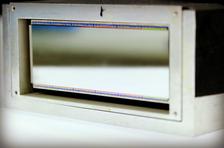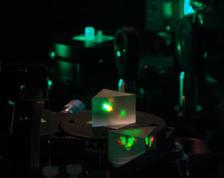Die sensitive Fläche des LAMBDA-Detektors (Foto: Daniela Becker/DESY).
Two start-up companies initiated by DESY scientists will be funded by the Helmholtz Association “Helmholtz Enterprise” support programme: The X-Spectrum company, entering the market with a high-technology X-ray detector, will receive 100 000 euros. The Class 5 Photonics company will build very flexible femtosecond-lasers generating short pulses with high performance. The joint spin-off of DESY and the Helmholtz Institute Jena will be financed with almost 130 000 euros.
In July, the X-Spectrum company was founded by five members of the DESY detector development group (FS-DS), with DESY being the sixth associate of this new enterprise. The scientists developed an X-ray area detector named LAMBDA, offering an extremely high spatial resolution and a high recording rate. LAMBDA stands for Large Area Medipix Based Detector Array. The large active area of the LAMBDA detector with the size of about nine by three centimetres is equipped with 750 000 pixels and takes up to 2000 images per second. Each pixel performs single light particle (photon) counting, but can also handle rates of more than 500 000 photons per second. This very high dynamic range is complemented with the possibility to measure the energy of the detected X-ray particles, i.e. practically taking colour pictures. “High sensitivity, high resolution, high frame rate – thus, the detector precisely fulfils the requirements experimenters put on new generation synchrotron radiation detectors,” said Heinz Graafsma, DESY scientist and one of the X-Spectrum managing directors. “Moreover, the detector is suitable for photon energies up to about 100 kilo-electronvolts, which we have for example at PETRA III.” For comparison: This is about 40 000 times higher than the energy of visible light, which is for example recorded by the chip of an average digital camera.
The short and highly intensive X-ray flashes of third generation research light sources as PETRA III allow to conduct experiments much faster than this was possible in the past. However, this also presents new challenges to the detectors which are used at these sources: It requires both, a high resistance against the intensive radiation and a sufficiently large area to obtain as much image information as possible in one frame. The higher the sensitivity and the frame rate to read-out the detector, the faster experiments can be carried out.
The sensor of the LAMBDA detector is made from silicon or gallium arsenide for lower and higher photon energies, respectively, and is subdivided in small pixels of 55 micrometre size. To reach the high frame rate, it is readout by a medipix3 chip. This chip was developed in an international cooperation of more than 20 research institutes especially to readout these sensors. “The Medipix3 chip is the backbone of the detector,” said Graafsma. “It enables the high readout rate of 2000 Hertz for all 750 000 pixels simultaneously. This makes our detector to be top-class.” Despite its power, the detector does not need special cooling. “practically, the whole detector is a plug&play system which only requires convection cooling,” emphasises Stefanie Jack, second managing director of X-Spectrum. “We hope that the easy handling, combined with the excellent specifications, will make the detector very attractive for X-ray scientists worldwide.”
For the future, X-Spectrum plans the commercialisation of the existing versions of the LAMBDA detector system, but also the development of special systems for experiments at free-electron lasers in the soft and hard X-ray range. Moreover, the scientists are already thinking about application possibilities in industry.
The second spin-off funded by “Helmholtz Enterprise” is the Class 5 Photonics company, currently in the process of foundation, which will place on the market tunable femtosecond lasers with a high pulse rate. With this concept, the future entrepreneurs recently won the Start-up Challenge prize of the German Competence Networks for Optical Technologies OptecNet (see DESY press release of 27 May 2014).
Press Release of the Helmholtz Association
(from DESY news)








